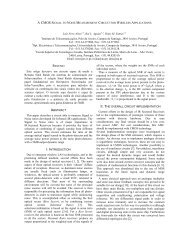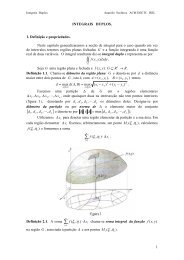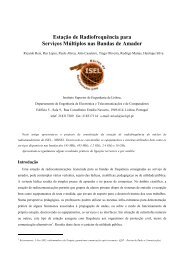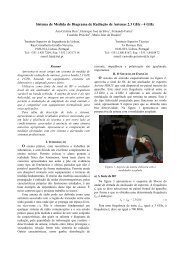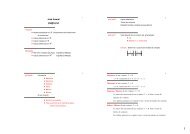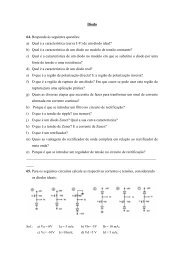Transformações Lineares de Rn em Rm - deetc
Transformações Lineares de Rn em Rm - deetc
Transformações Lineares de Rn em Rm - deetc
Create successful ePaper yourself
Turn your PDF publications into a flip-book with our unique Google optimized e-Paper software.
T R A N S F O R M A Ç Õ E S L I N E A R E S D E R N E M R M A L G E B R A – T U R M A L R 1 1 D<br />
2. Como vimos, da aplicação da transformação linear,<br />
a qualquer objecto <strong>de</strong><br />
ao eixo dos yy<br />
w = Ax<br />
⎡w1<br />
⎤ ⎡− 1<br />
⎢ ⎥ = ⎢<br />
⎣w2<br />
⎦ ⎣ 0<br />
0⎤⎡x⎤<br />
1<br />
⎥⎢<br />
⎥<br />
⎦⎣y<br />
⎦<br />
© Prof. José Amaral ALGA M06 - 22 12-11-2007<br />
2<br />
2<br />
T : R → R , w = T(<br />
x,<br />
y)<br />
2<br />
R resulta uma imag<strong>em</strong> que correspon<strong>de</strong> ao seu simétrico relativamente<br />
w = T( x,<br />
y)<br />
= ( −x,<br />
y)<br />
Aplicando a transformação ao ponto x = ( x,<br />
y)<br />
= ( 2,<br />
2)<br />
, resulta a imag<strong>em</strong> w = ( w,<br />
z)<br />
= ( −2,<br />
2)<br />
[ ] T<br />
2 2<br />
figure(5);clf<br />
x=[2 2]'<br />
A = [-1 0; 0 1] % REFLEXÃO Y<br />
w=A*x<br />
hold on<br />
plot(x(1),x(2),'*k');<br />
plot(w(1),w(2),'*r');<br />
hold off<br />
axis([ -4 4 -4 4])<br />
Note que o ponto é representado por uma matriz coluna,<br />
x = , resultando, por aplicação da transformação, a imag<strong>em</strong><br />
⎡− 2⎤<br />
⎡− 1 0⎤<br />
⎡2⎤<br />
w = Ax = ⎢ ⎥ = ⎢ ⎥ ⎢ ⎥<br />
⎣ 2⎦<br />
⎣ 0 1⎦<br />
⎣2⎦<br />
Aplicando a transformação ao conjunto <strong>de</strong> pontos ( x 1 , y1)<br />
= ( 2,<br />
2)<br />
, ( x 2 , y2)<br />
= ( 2,<br />
3)<br />
,<br />
( x 3 , y3)<br />
= ( 3,<br />
3)<br />
, ( x 4 , y4<br />
) = ( 3,<br />
2)<br />
, resulta o conjunto <strong>de</strong> imagens ( w 1,<br />
z1)<br />
= ( −2,<br />
2)<br />
,<br />
( w 2,<br />
z2)<br />
= ( −2,<br />
3)<br />
, ( w 3,<br />
z3<br />
) = ( −3,<br />
3)<br />
, ( w 4,<br />
z4<br />
) = ( −3,<br />
2)<br />
,<br />
figure(6);clf<br />
x1=[2 2]'; x2=[2 3]'; x3=[3 3]'; x4=[3 2]';<br />
X=[x1 x2 x3 x4]<br />
T = [-1 0; 0 1] %REFLEXÃO Y<br />
W=T*X<br />
hold on<br />
plot(X(1,:),X(2,:),'*k');<br />
plot(W(1,:),W(2,:),'*r');<br />
axis([ -4 4 -4 4])<br />
hold off<br />
Note que cada um dos pontos foi representado por uma matriz coluna [ ] T<br />
x i = xi<br />
yi<br />
. A matriz<br />
X é uma matriz <strong>de</strong> 2 × 4 <strong>em</strong> que cada uma colunas correspon<strong>de</strong> a cada um dos pontos objecto.<br />
Por aplicação da transformação, obt<strong>em</strong>os a matriz W , 2 × 4 , <strong>em</strong> que cada uma das colunas<br />
correspon<strong>de</strong> a cada um dos pontos imag<strong>em</strong><br />
w<br />
1<br />
⎡− 2 − 2 − 3 − 3⎤<br />
⎡− 1<br />
= ⎢<br />
⎥ = ⎢<br />
⎣ 2 3 3 2⎦<br />
⎣ 0<br />
0⎤<br />
⎡2<br />
1<br />
⎥ ⎢<br />
⎦ ⎣2<br />
2<br />
3<br />
3<br />
3<br />
3⎤<br />
2<br />
⎥<br />
⎦




